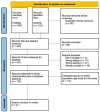Flexible Resources Key to Neighborhood Resilience for Children: A Scoping Review
- PMID: 38002882
- PMCID: PMC10670030
- DOI: 10.3390/children10111791
Flexible Resources Key to Neighborhood Resilience for Children: A Scoping Review
Abstract
Neighborhoods have been the focus of health researchers seeking to develop upstream strategies to mitigate downstream disease development. In recent years, neighborhoods have become a primary target in efforts to promote health and resilience following deleterious social conditions such as the climate crisis, extreme weather events, the global pandemic, and supply chain disruptions. Children are often the most vulnerable populations after experiencing unexpected shocks. To examine and describe conceptually the construct of Neighborhood Resilience, we conducted a comprehensive scoping review using the terms ("resilience" or "resiliency" or "resilient") AND ("neighborhood"), utilizing MEDLINE (through PubMed) and CINAHL (through EBSCOhost) databases, to assess overall neighborhood themes that impact resilience. A total of 57 articles were extracted that met inclusion criteria. Extracted characteristics included study purpose, country of origin, key findings, environmental protective/risk factors. The analysis revealed a positive relationship between neighborhood resource density, neighborhood resiliency, and individual resiliency. This study reports the finding for studies with a population focus of pre-school age and school age children (1.5-18 years of age). Broadly, we identified that the primary goals regarding neighborhood resilience for childhood can be conceptualized as all activities and resources that (a) prevent trauma during childhood development and/or (b) mitigate or heal childhood trauma once it has occurred. This goal conceptually encompasses antecedents that increase protective factors and reduces risk factors for children and their families. This comprehensive look at the literature showed that a neighborhood's ability to build, promote, and maintain resiliency is often largely dependent on the flexible resources (i.e., knowledge, money, power, prestige, and beneficial social connections) that are available.
Keywords: adverse childhood experiences; neighborhoods; stress resilience.
Conflict of interest statement
The authors declare no conflict of interest.
Figures
Similar articles
-
Beyond the black stump: rapid reviews of health research issues affecting regional, rural and remote Australia.Med J Aust. 2020 Dec;213 Suppl 11:S3-S32.e1. doi: 10.5694/mja2.50881. Med J Aust. 2020. PMID: 33314144
-
What Have We Learnt About the Sourcing of Personal Protective Equipment During Pandemics? Leadership and Management in Healthcare Supply Chain Management: A Scoping Review.Front Public Health. 2021 Dec 9;9:765501. doi: 10.3389/fpubh.2021.765501. eCollection 2021. Front Public Health. 2021. PMID: 34957018 Free PMC article.
-
Family-, School-, and Neighborhood-Level Predictors of Resilience for Adolescents with a History of Maltreatment.Children (Basel). 2022 Dec 20;10(1):1. doi: 10.3390/children10010001. Children (Basel). 2022. PMID: 36670552 Free PMC article.
-
Methods to Assess Adverse Childhood Experiences of Children and Families: Toward Approaches to Promote Child Well-being in Policy and Practice.Acad Pediatr. 2017 Sep-Oct;17(7S):S51-S69. doi: 10.1016/j.acap.2017.04.161. Acad Pediatr. 2017. PMID: 28865661 Free PMC article.
-
The impact of climate change related extreme weather events on people with pre-existing disabilities and chronic conditions: a scoping review.Disabil Rehabil. 2023 Dec;45(25):4338-4358. doi: 10.1080/09638288.2022.2150328. Epub 2022 Nov 25. Disabil Rehabil. 2023. PMID: 36426560
Cited by
-
Extreme weather and climate-related adverse childhood experiences are a humanitarian crisis during the 21st century.Commun Med (Lond). 2025 Aug 18;5(1):357. doi: 10.1038/s43856-025-01089-x. Commun Med (Lond). 2025. PMID: 40826225 Free PMC article. Review.
References
-
- Rajmil L., Fernandez de Sanmamed M.J., Choonara I., Faresjö T., Hjern A., Kozyrskyj A.L., Lucas P.J., Raat H., Séguin L., Spencer N., et al. Impact of the 2008 economic and financial crisis on child health: A systematic review. Int. J. Environ. Res. Public Health. 2014;11:6528–6546. doi: 10.3390/ijerph110606528. - DOI - PMC - PubMed
-
- Hayhoe K., Wuebbles D.J., Easterling D.R., Fahey D.W., Doherty S., Kossin J.P., Sweet W.V., Vose R.S., Wehner M.F. Chapter 2: Our Changing Climate. Impacts, Risks, and Adaptation in the United States. The Fourth National Climate Assessment. Volume II. Global Change Research Program; Washington, DC, USA: 2018. - DOI
-
- Islam M.S., Sharker M.A.Y., Rheman S., Hossain S., Mahmud Z.H., Islam M.S., Uddin A.M.K., Yunus M., Osman M.S., Ernst R., et al. Effects of local climate variability on transmission dynamics of cholera in Matlab, Bangladesh. Trans. R. Soc. Trop. Med. Hyg. 2009;103:1165–1170. doi: 10.1016/j.trstmh.2009.04.016. - DOI - PubMed
Publication types
Grants and funding
LinkOut - more resources
Full Text Sources
Miscellaneous


